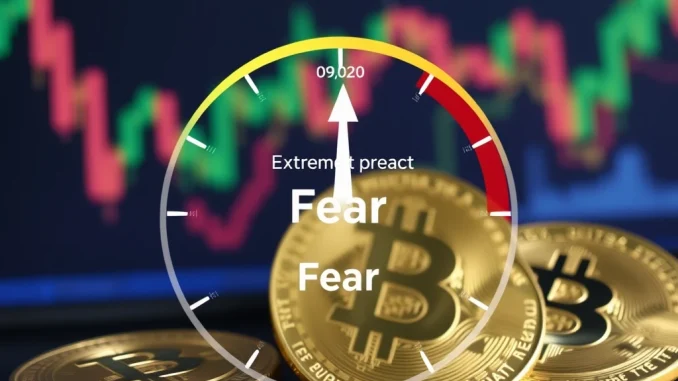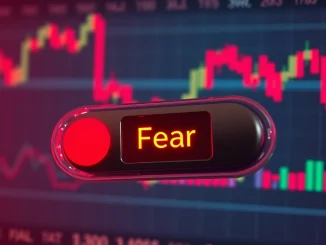
Ever felt that rollercoaster of emotions when you’re in the crypto market? One minute you’re riding high on potential gains, the next you’re gripped by the fear of a sudden dip. Well, you’re not alone! Savvy crypto enthusiasts and seasoned investors alike keep a close eye on tools that help gauge the overall market mood. One such crucial indicator is the Crypto Fear and Greed Index. Let’s dive into the latest reading and understand what it signals for your crypto portfolio.
Navigating Crypto Market Sentiment with the Fear & Greed Index
As of April 18th, the Fear and Greed Index, a popular metric from Alternative.me, registered a score of 33. This marks a slight uptick of three points from the previous day. While any positive movement might seem encouraging, it’s important to note that a score of 33 firmly plants us within the ‘Fear’ zone. But what exactly does this mean, and why should you care?
The Crypto Fear and Greed Index isn’t just a random number generator. It’s a carefully constructed gauge designed to capture the prevailing emotions and sentiment within the cryptocurrency market. Think of it as a mood ring for the crypto world. It helps us understand whether the market is currently dominated by fear, which often signals potential buying opportunities, or greed, which might suggest an overheated market ripe for correction.
Understanding the Fear & Greed Index: A Deep Dive
To truly appreciate the value of the Fear and Greed Index, it’s essential to understand how it works. This index operates on a scale from 0 to 100. Let’s break down what each end of the spectrum represents:
- 0-24: Extreme Fear – This zone screams ‘oversold market’. Investors are panic-selling, and prices are often depressed. Historically, extreme fear can present compelling buying opportunities for those with a long-term perspective.
- 25-49: Fear – While not as extreme as the lowest range, the ‘Fear’ zone still indicates a cautious market. Investors are apprehensive, possibly due to negative news, market uncertainty, or recent price drops. This zone can also offer potential entry points for strategic investors.
- 50-74: Greed – As we move into ‘Greed’, market sentiment shifts. Investors become more optimistic, prices tend to rise, and FOMO (Fear Of Missing Out) can start to kick in.
- 75-100: Extreme Greed – This is where caution flags should be waving wildly! ‘Extreme Greed’ suggests a potentially overheated market bubble. Everyone is bullish, prices may be unsustainable, and a correction could be on the horizon.
Currently, with the index at 33, we are clearly in the ‘Fear’ territory. This suggests that despite the recent minor improvement, a significant portion of the crypto market remains cautious and potentially worried about further price declines.
What Factors Influence the Crypto Fear Index?
The beauty of the crypto fear index lies in its multifaceted approach. It doesn’t rely on just one data point but rather aggregates information from six different sources to paint a holistic picture of market sentiment. Let’s explore these components:
- Volatility (25%): Market volatility is a key indicator of fear. High volatility, especially sudden and sharp price swings, often triggers fear-based reactions from investors. The index analyzes the current volatility and compares it to historical averages to gauge the level of fear.
- Market Momentum/Volume (25%): Strong positive momentum and high buying volume typically indicate greed, while weak momentum or declining volume can signal fear. The index examines market momentum relative to recent averages to assess market strength.
- Social Media (15%): Social media platforms like Twitter and Reddit are goldmines of real-time sentiment. The index analyzes social media trends, hashtags, and engagement to understand the prevailing emotions of crypto communities. A surge in negative sentiment online can contribute to a lower index score.
- Surveys (15%): While less frequent than other factors, periodic crypto surveys directly gauge investor sentiment. These surveys ask participants about their current market outlook, providing direct insights into fear or greed levels.
- Bitcoin Dominance (10%): Bitcoin’s dominance in the crypto market can be a sentiment indicator. In times of fear, investors often flock to Bitcoin as a perceived ‘safe haven’, increasing its dominance. Conversely, during periods of greed, investors may be more willing to venture into altcoins, reducing Bitcoin’s dominance.
- Google Trends (10%): Google Trends data reveals what people are searching for online. Spikes in searches for terms like “Bitcoin crash” or “crypto sell-off” can indicate fear, while searches for “buy Bitcoin” or “best altcoins” might suggest greed.
Why is the Crypto Fear & Greed Index Important for You?
So, why should you, as a crypto enthusiast or investor, pay attention to the Crypto Fear and Greed Index? Here are a few compelling reasons:
- Gauge Market Mood: It provides a quick and easy way to understand the overall sentiment in the crypto market. Are people generally fearful or greedy? This index gives you a data-backed answer.
- Identify Potential Buying Opportunities: Historically, periods of extreme fear have often been followed by market recoveries. A high fear reading can signal that assets are undervalued and present a potential buying opportunity – remember the Warren Buffett quote, “Be fearful when others are greedy and greedy when others are fearful.”
- Recognize Market Tops: Conversely, extreme greed can be a warning sign of an overheated market. When everyone is euphoric and the index is sky-high, it might be time to exercise caution and consider taking profits.
- Enhance Your Trading Strategy: Whether you’re a day trader or a long-term holder, the index can be a valuable tool to incorporate into your decision-making process. It can help you refine your entry and exit points based on broader market sentiment.
- Manage Emotional Trading: Fear and greed are powerful emotions that can lead to impulsive and irrational trading decisions. By using the index, you can ground your decisions in data rather than pure emotion, potentially leading to more rational and profitable outcomes.
Is the Fear Zone a Buying Opportunity?
With the Crypto Fear and Greed Index currently in the ‘Fear’ zone, the burning question is: Is this a buying opportunity? While the index itself doesn’t provide financial advice, historical data suggests that periods of fear can indeed be opportune times to accumulate crypto assets.
However, it’s crucial to remember that the index is just one tool in your arsenal. It shouldn’t be the sole basis for your investment decisions. Always conduct thorough research, consider your own risk tolerance, and diversify your portfolio.
Key Considerations When Interpreting the ‘Fear’ Zone:
| Consideration | Description |
|---|---|
| Market Fundamentals | Assess the underlying fundamentals of the cryptocurrencies you’re interested in. Are the projects still strong? Is adoption growing? Fear can sometimes overshadow solid fundamentals. |
| Broader Economic Conditions | Consider the macroeconomic environment. Are there global events or economic factors contributing to market fear? Understanding the bigger picture is crucial. |
| Your Investment Horizon | Are you a short-term trader or a long-term investor? Fear-driven dips can be excellent long-term buying opportunities, but short-term volatility can still be significant. |
| Risk Management | Never invest more than you can afford to lose. Even in a ‘Fear’ zone, further price declines are possible. Proper risk management is paramount. |
The Crypto Fear & Greed Index: A Compass, Not a Crystal Ball
In conclusion, the Crypto Fear and Greed Index, currently at 33 and in the ‘Fear’ zone, serves as a valuable compass for navigating the often turbulent waters of the cryptocurrency market. It’s a powerful tool for understanding crypto market sentiment and can provide crucial insights into potential buying or selling opportunities.
While the slight increase to 33 from the previous day might offer a glimmer of hope, the persistent ‘Fear’ reading underscores the ongoing caution and anxiety within the crypto space. By understanding how this index works, what factors influence it, and how to interpret its readings, you can make more informed decisions, manage your emotions more effectively, and potentially capitalize on market fluctuations. Remember, the index is a guide, not a guarantee. Use it wisely, combine it with your own research and due diligence, and you’ll be better equipped to thrive in the exciting and ever-evolving world of crypto.



